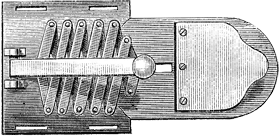
|
foreword to the online edition I. introductory II. common sharpers and their tricks III. marked cards and the manner of their employment IV. reflectors V. holdouts VI. manipulation VIII. the game of faro IX. prepared cards X. dice XI. high ball poker XII. roulette and allied games XIII. sporting houses XIV. sharps and flats
|
SHARPS AND FLATS
CHAPTER V HOLDOUTS
The "Jacob's Ladder" Sleeve HoldoutThis brings us, then, to the subject of sleeve machines, or appliances whereby the sharp, like Ah Sin, the 'Heathen Chinee,' who understood so well 'the game he did not understand,' is enabled to have a few cards up his sleeve. 'Up his sleeve!' How those words suggest the explanation so often given by the innocent-minded public to account for the disappearance of the various articles which slip so nimbly through a conjurer's fingers. And yet, if they only knew it, that is about the last place in the world that a conjurer, as a rule, would use as a receptacle for anything. Of course there is no Act of Parliament to prevent him, should he desire to do so; but that's another story. With the sharp, however, there are several Acts of Parliament to prevent him from using his sleeve for any such purpose; and yet he often resorts to it. How true is the saying that 'one man may steal a horse, whilst another may not look over the hedge.'
FIG. 30 As far as can be ascertained, the 'Jacob's Ladder' was the forerunner of all other sleeve holdouts. It was fastened to the under side of the fore-arm, and worked by pressure upon the table. Its construction was essentially that of a pair of lazy -tongs, arranged as in figs. 30 and 31. The base-plate carrying the working parts was curved so as to lie closely against the arm and hold the machine steady whilst in use. The 'lazy- tongs' device was fixed to the base-plate at one end, the other being free to move, and carrying the clip for the cards. Situated at an angle above the 'tongs' was a lever, also attached at one end to the base-plate, the other end terminating in a knob. Halfway down this lever was hinged a connecting-rod, joining the lever with the second joint of the 'tongs.' Pressure being applied to the knob, the connecting-rod would force out the joint to which it was attached; and the motion being multiplied by each successive joint, the clip was caused to protrude beyond the coat cuff. In this position the card could be inserted or removed as in the cases already noticed. The clip was returned to its place within the sleeve by means of a rubber band. FIG. 31 Some of these 'Jacob's ladder' sleeve machines are made to work by pulling a string, after the manner of the coat and vest machine already described. Those advertised at $50.00 are of this description. The advantage of a machine of this kind is of course found in the fact that the cards are brought directly into the hand. This particular form, however, was very difficult to use, as the cards were always liable to catch, in the cuff, a circumstance which is obviously much to the detriment of the apparatus. There is also the further disadvantage of being compelled to wear an abnormally large shirt-cuff, which in itself would attract attention among men who had their wits about them. The enormous facilities for unostentatious operation afforded by a machine working inside the sleeve were too readily apparent to allow of the sleeve holdout falling into disuse. It was the kind of thing which must inevitably be improved upon, until it became of practical utility. And such has been the case. The very finest holdout the world has ever seen is that known as the Kepplinger or San Francisco. This machine in its latest forms is certainly a masterpiece. Yet so little appreciation has the world for true genius, that the inventor of this marvelous piece of apparatus is practically unknown to the vast majority of his fellow-men.
|
| « holdouts (the vest holdout) | holdouts (the Kepplinger holdout) » |
home | introduction | book content | links | advertising | contact

